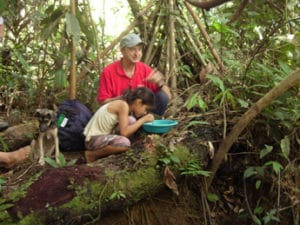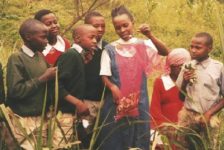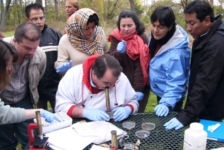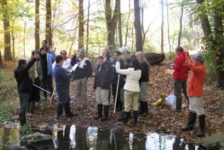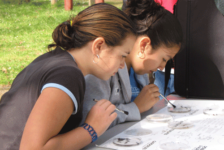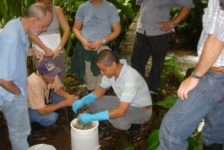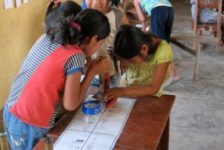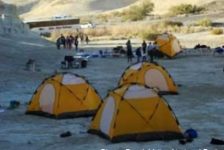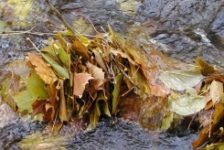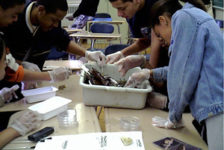“As individuals, as institutions, as a people we need a change of heart to preserve and protect the planet for our children and for generations yet unborn.” Renewing the Earth, U.S. Catholic Bishops, 1991, p. 3.
Leaf Pack Experiments in Yosemite National Park
By Adam Burns, Ph.D., Director, Yosemite Institute
Yosemite Institute, a campus of NatureBridge, is a non-profit organization that provides outdoor education programs in Yosemite National Park with the goal of inspiring a personal connection to the natural world and responsible actions to sustain it.
In September 2009, Yosemite Institute began using leaf packs to study macroinvertebrates in four streams in Yosemite Valley. Students have been studying water chemistry in these streams for several years but institute staff felt that biomonitoring would provide a more accurate measurement of the health of these ecosystems. Because of the unique nature of our outdoor classroom, there are restrictions on collecting live animals. Leaf packs are a great way for us to sample macroinvertebrates while minimizing our impact on stream ecosystems.
By placing leaf packs in streams regularly throughout the year, it is possible for us to monitor seasonal changes in the macroinvertebrate community, as well as drawing comparisons between streams.
Our macroinvertebrate studies have quickly become one of our most popular activities. With the help of our talented field educators, these wonderful animals are inspiring, fascinating and educating the next generation of environmental stewards.
At Yosemite Institute, we strive to give our students an experience that goes beyond that of the average national park visitor. We show them the hidden secrets of Yosemite that make it such a magical place. The discovery of diverse and thriving macroinvertebrate communities in our streams fulfills this mission perfectly. The fact that we are collecting meaningful scientific data while we’re having so much fun feels very satisfying.
The major challenge that we are facing with this project is the extremely variable flow of our rivers. As spring arrives and the snow in the High Sierra’s melts, trickling creeks turn into roaring torrents, threatening to carry away our leaf packs! Because of this, we suspend our studies during this particularly unpredictable season. We always look forward to restarting our leaf pack project later in the spring.
Forester Creek Recovery: San Diego Area Volunteers Collaborate to Document Improvement of Urban Stream
By Jessica Kelly, Senior at Mount Miguel High School, Spring Valley, CA
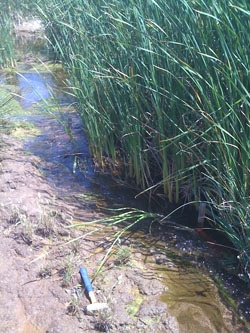
A new beginning: various grasses and reeds were used to fill two leaf packs in Forester Creek, an urban stream in Santee, CA, that was rehabilitated as part of the extension of the 125 freeway just west of the Leaf Pack test site.
Forester Creek, which is located in Santee, CA, recently underwent the city’s largest capital improvement project ever under taken: the $40 million Forester Creek Improvement Plan.
Before the project began, Forester Creek constantly flooded and was a polluted eyesore. After the improvement project, it is able to contain a 100-year flood and has several walking paths where visitors can immerse themselves in the plants and wildlife that find their homes in Forester Creek.
At the time of our team’s bioassessment, there was a highway extension being constructed in close proximity to Forester Creek. We chose Forester Creek to do our bioassessment because it underwent so many recent changes and it is part of the San Diego River Basin. Also, it is close to our school and easily accessible, so it would be a great site for a future Science Fair projects.
June 3, 2010 – Two weeks after our team staked two bags of leaves in Forester Creek, hoping to tempt the local macroinvertebrates, Mount Miguel High School’s Biochemistry class returned to Forester Creek to do a bioassessment of the water.

A collaborative effort: Gary Strawn of the San Diego Stream Team explains stream characteristics to volunteers from Mt. Miguel High School, Spring Valley, and Mission Trails Regional Park, San Diego.
After hiking down to the creek, we used a probe to simultaneously test the water’s pH, temperature, conductivity, and turbidity. We crossed to the other side of the creek and collected our first leaf pack. We placed the macroinvertebrates and leaves into two buckets along with some water from the creek.
We then got to work separating the macroinvertebrates into their own petri dishes.
We counted out the amount of different insects we had in each petri dish after 30 minutes, recorded our data then released them back into the water. We repeated this process for the second leaf pack.
After submitting our data to the Leaf Pack Network® we found that Forester Creek has a Biotic Index score of 5.49. Our class discussed possible reasons for our fair rating some of which are agricultural runoff, erosion from the nearby construction site, urban pollution from the surrounding neighborhoods and commercials zones, and possibly our own human error.
Our class brainstormed ways to reduce human error during future tests. Our solution was to sort the insects into sections of ice cube trays, then have students identify them before placing them into separate petri dishes. We felt that this would prevent them from only going after the large macroinvertebrates or the “interesting” ones that move a lot.
Our class hopes to do a bioassessment of Forester Creek next year and is interested in seeing if there are any changes.

Streamside identification: Michael Heimer, senior, and Todd Linke, biochemistry teacher, record tallies as other students sort and identify macroinvertebrates alongside Forester Creek.
Leaf Pack Experiment Continues to Spread Throughout Peru
Stroud Water Research Center Director and Senior Research Scientist, Bernard Sweeney, and Educator, Christina Medved, traveled to Lima, Peru, this past September to provide Leaf Pack workshops to teachers, environmental educators and industry professionals. The workshops were located in Iquitos and Pucallpa – both are towns within the lowlands of the Amazon River basin. Joining us as educators on the trip were Wills Flowers, Professor at Florida A&M University, Fernando Ollervides, Senior Field Coordinator at Waterkeeper Alliance, and Therany Gonzales-Ojeda, Peruvian Leaf Pack Ambassador.
View a photo album of our trip
Macroinvertebrate Identification Resource
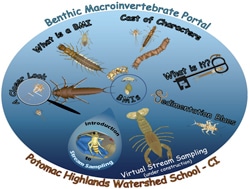 The Cacapon Institute in West Virginia put together a rich macroinvertebrate identification resource.
The Cacapon Institute in West Virginia put together a rich macroinvertebrate identification resource.
Go to the Benthic Macroinvertebrate Portal and choose from:
- Introduction to Stream Sampling
- A Closer Look
- What is a BMI?
- Cast of Characters
- What Is It?
- Sedimentation Blues
- A Virtual Stream Sampler
Updated Leaf Pack Network® Manual
The LPN manual can be downloaded in English as well as Spanish. Please visit this link to download the most updated version of the manual.
Note: The Spanish version of the LPN manual also includes specific instructions for conducting leaf pack experiments in tropical streams.



